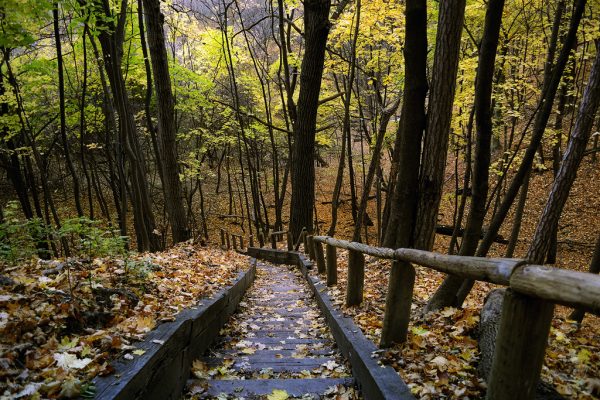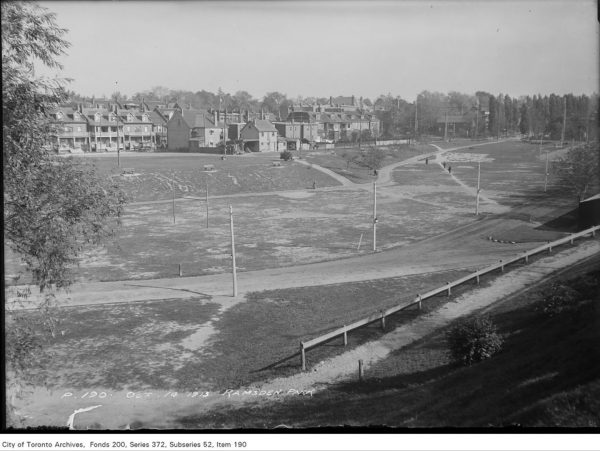My inbox has been filling up all summer and into this balmy fall with the righteous indignation of two well-heeled neighbourhood groups whose members profess to be defending the ecological integrity of local parks in the face of municipal outrages.
In Ramsden Park, one group reared up over the evidently distressing prospect of a wheelchair accessible switchback ramp along the south slope, near Hillsboro Ave., to be installed as part of a $7 million revitalization. The project, a spokesperson says, is overly expensive, unnecessary, and will lead to the destruction of “countless” trees in a park that was, apparently, part of Toronto’s ravine system. This last claim could be true, but, as the area’s residents undoubtedly know, their park has been partially dominated by a municipal works yard since the 1920s.
Meanwhile, over in beleaguered Rosedale, another group has been demonstrating in recent days over the long-delayed construction of a switchback path linking Chorley Park and the Mud Creek/Evergreen Brickworks trail, a project they’ve known about for two years, and which has been subjected to all manner of public consultations, design tweaking, and engagement with municipal officials.
The Friends of Chorley Park is clearly a media savvy group, and their stagey protests are apparently meant to raise the profile of this latest species of incursion on environmentally sensitive ravine slopes.
Except, of course, their outrage – served up with a side of photos of placard-carrying Rosedalians — has nothing whatsoever to do with these ostensible concerns, any more than the Ramsden Park controversy is about a ravine park.
Indeed, ask yourself when was the last time you heard of groups in Rosedale or Moore Park or Cedarvale staging demonstrations about the long-standing practice of affluent ravine-lot owners fencing off parts of those same slopes for their own personal use. Never, that’s when.
Let me offer a few brief observations about ravine slopes in Toronto, a great many of which would have been denuded and scruffy-looking in a previous era of the city’s development.
As anyone who’s strolled through the Mud Creek ravine will well know (Chorley Parkers, I’m looking at you), cleared areas rejuvenate remarkably quickly, as a recently completed path reconstruction project amply demonstrated. And of course, the Brickworks itself is a spectacular example of not only the ecological resilience of this particular ecosystem (Carolinian forest), but also the ways in which man-made (and accessible) paths can co-exist with re-naturalized spaces.
Exhibit B: a wheelchair/stroller accessible switchback trail built well over a generation ago from Blythwood Road down a slope and into Sherwood Park. When the City decided to replace a rickety old creosote-soaked railway-tie staircase with a properly inclined ramp, parks crews had to clear the slope.
And guess what? It all grew back, and then some, and did so quickly. Today, you can barely see the switchback.
In that case, there were no protests because the path provided Lawrence Park parents pushing strollers with more straightforward access to the park and the playground a few hundred metres away.
So if one is to take these gripes at face value, it’s difficult to know what the big deal is. We can all reconvene in five or ten years and that apparently desecrated slope falling away from Chorley Park will look pretty much as it did earlier in the summer, before it was cleared, except that it will also contain a properly inclined and landscaped path linking one part of the city to its ravine system.
Of course, it’s the prospect of that linkage – and fears of the foot traffic through this enclave – which puts the lie to all the local protestation, although I boldly predict that Rosedale’s activists will be the first to use the path as a short-cut down to the Brickwork’s farmer’s market or a morning stroll in the ravine.
When I wrote about Chorley for the Globe and Mail almost two years ago, a local spokesperson teed up the classic NIMBY excuse – there’s access to the ravine trail via the parking lot in front of the Brickworks (i.e., elsewhere), so why is this secondary entrance necessary? Similar objections have surfaced with the proposed Ramsden ramp.
If you navigate the city in a wheelchair or motorized scooter, you’ve surely heard that song before: there’s an entrance around the back or through the loading dock. It’ll have to do, and remember to contact the caretaker before you arrive, etc.
Yet for a whole range of people with a whole range of mobility issues – everyone from parents with strollers to active seniors with cranky knees – this infrastructure levels the accessibility playing field and makes the city’s public spaces more democratic, more universal and less contingent on provisional solutions. That’s the genius behind universal design.
Quite apart from the policy and design particulars, these two attempts to gum up the City’s efforts to make parks and ravines more accessible raise tough questions about park-focused advocacy groups.
In recent years, Park People and other civic-minded organizations have advanced ideas such as parks conservancies and talked up the constructive role that “Friends of” groups can play in terms of advocating for vibrant public spaces.
I don’t want to suggest that the animating principles behind such efforts aren’t laudable: Jane Jacobs’ ‘eyes on the street’ formulation applies to parks, and the notion of creating more opportunities for residents to engage with the city’s public spaces is, of course, important.
But as the Ramsden and Chorley stories suggest, there’s a blurry line between inclusive engagement and exclusion-minded lobbying. As is the case with many homeowners associations, the members of ‘Friends’ organizations may come to regard themselves as neighbourhood gatekeepers and arbiters.
A well-loved local park is an intimate refuge that prompts understandable feelings of ownership among those who use it regularly. But that subset of locals who have stepped up to raise funds for a conservancy or serve on the board of a Friends group may go one step further and conclude that they are therefore entitled to dictate to the City what should and should not pass muster in their parks.
Which is exactly what’s happened with Chorley and Ramsden. And potentially other parks.
As the emails I’ve been receiving from the Ramsden group clearly indicate, their organizers drew encouragement and inspiration from the Chorley Park protesters. The narrative and techniques of oppositional, well-resourced advocacy are not only transferable; they are also readily concealed in the more benign guise of environmental and parks-oriented stewardship.
With Chorley Park, Kristyn Wong-Tam, the local councillor, knew the game and stood up to the neighbourhood’s pressure tactics. Other councillors may have less backbone because they’re more beholden to homeowner groups. So even though these switchbacks will be constructed, those who advocate for universal access should all be deeply concerned about the precedent that’s been set.







6 comments
Not ONE of the huge trees that fell during the ice storms at Ramsden Park alongside the Pears Avenue sidewalk have been replaced. But hey, all the brand new tennis courts and over-safe children’s playground certainly look swanky.
So much for tall hat vaunted environmental and parks-oriented stewardship.
Not one. Neither provincial or other belongs to our charity, recognized by the Government of Ontario and over 240 other municipalities and land managers as the lead in trail management, use, development and preservation. That should tell you what they are about. If they were members we’d have a way to council together on issues. http://ontariotrails.ca
At the risk of being smeared by Mr. Lorinc as a well-heeled Rosedalian NIMBY, I have to disagree on Chorley. First, the short switchback from the Brickworks to Mud Creek isn’t some back entrance by the loading dock. It’s the main (and until this year the only) access from the Brickworks to the Mud Creek trail for everyone, and it’s around two hundred metres from the endpoint of the Chorley switchback. The Brickworks has a regular, accessible TTC bus from the elevator-equipped Davisville subway station, as well as parking and space for Wheel Trans drop-off. Rosedale Station doesn’t have an elevator, and the way this city works might get one in a hundred years or so. The City and Kristyn Wong-Tam consistently and dishonestly ignored this access. Second, the two clear cuts have destroyed around two hundred trees by the City’s count, along with a mature canopy that simply won’t grow back in the lifetime of many of us. Contrary to Mr. Lorinc’s assertion, forests don’t magically regenerate after a decade. Third, Friends of Chorley Park hired a landscape architect to produce an AODA-compliant trail that would not have relied on the destruction of the forest. The City deemed this unacceptable even though it met provincial disability standards. So, Kristyn Wong-Tam has destroyed a rare piece of our urban forest when a better, cheaper, greener alternative existed. And, John, one more thing. Ad hominem is about the lowest form of argument, so I’d appreciate it if you’d stop demonizing my neighbours and me just because we live in Rosedale. We’re against the Chorley Trail because we’re dismayed by the destruction of a precious urban forest that belongs to all the people of Toronto, not because we’re a bunch of NIMBY’s who hate disabled people.
John,
With regard to the Ramsden ramp, you are missing the point entirely. What is happening with the opposition to the Ramsden Park ramp has nothing to do with exclusion and everything to do with inclusion. Those opposed to the ramp want a better and safer entrance than currently exists at the HIllsboro entrance and are in favour of accessibility for everyone, but the proposed ramp will not achieve this.
As the city does not clear paths, ramps and staircases of ice and snow in the winter, no one will be able to use the ramp when snow and ice accumulate during inclement weather.
It is also a matter of the ramp design being flawed (in addition to being exorbitantly expensive for something that will not be used)
Everyone, including those with rickety knees and parents with strollers will find it cumbersome to navigate the ramp which will be 187 m long. It will take forever to get up and down. My parents use wheelchairs and I will not be able to push them back up the ramp. And even the downward journey will require five exhausting switchbacks.
The CEO of Belmont House herself has stated that the residents of Belmont House (the most logical user group for the ramp) would not access the park via the Hillsboro entrance, with or without a ramp, as it is much safer for the seniors to cross the street at Yonge St. and access the park via the Yonge St. entrance rather than Davenport Rd. where cars whip around the corner.
Her concern is more with the uneven and un-repaired sidewalks which make many areas around Ramsden Park inaccessible for seniors and those using mobility devices. If a fraction of the ramp money were used for these kinds of upgrades, many more people could enter the park from all entrances. You can’t talk about making parks more accessible without looking at the bigger picture yet this issues has not been addressed by the City or by the councillor.
Last but not least, the proposed Ramsden ramp is not a pathway around which vegetation will re-grow. The ramp will be elevated, will be 2.1 m wide and as already mentioned, 187 m long. The massive rusted steel construction won’t leave much room on the small hillside for anything to grow.
I also take offence at your statement that those of us who are advocating for a more sensible access to the park at the Hillsboro entrance feel “entitled to dictate to the City what should and should not pass muster in their parks”. If it weren’t for advocacy groups such as Friends of Ramsden Park, some parts of Ramsden Park would have been lost to developers years ago, and no one would be currently holding the city staff accountable for promises made regarding Phase 1 of the park revitalization. There are flaws with the sandbox in the children’s playground (an unconnected drain pipe that is causing flooding), planting of trees that did not happen as proposed (2 flowering fruit trees promised at the Gibson St. gateway) and poorly sodded grass areas throughout the park.
Having been involved with the ramp issue for many months now and having attended several meetings with Councillor Wong-Tam and city staff, there is very little evidence that the City has the best interest of Ramsden Park users at heart.
Going forward I hope your coverage will be more balanced and informed and I would be happy to provide you with more information and details.
I gather from the replies above is that local residents without disabilities think that wheelchair users should be OK with having to take the bus around to the other side of a nearby park, instead of a ramp down into it? And I don’t quite see how wheeling *down* a ramp is “exhausting”, as suggested above? Quite the laundry lists of semi-rational argumentation here, that’s for sure.
Greg, no one is suggesting that wheelchair users “take a bus around to the other side of a nearby park”. The proposed ramp will be 187 m long and it is just over 200 m to take an alternate, and in winter much safer, entrance (starting at the Hillsboro entrance). Moreover, we are asking that the existing pathway at the Hillsboro entrance, which can be used with mobility devices, be upgraded and improved.
Since you bring up the use of a vehicle, I should also point out that the Yonge St. entrance to Ramsden Park offers ample parking while Hillsboro Ave. does not. So for anyone using a mobility device who wants to drive to the park, the Yonge St, entrance is far more convenient and suitable.
As for your comment about not understanding how wheeling down a ramp can be exhausting, I wonder whether you have ever pushed a non-electric wheelchair with a 200 lb person in it and navigated turning corners with it. Not everyone is in the fortunate position to be able to afford an electric or top-of-the-line wheelchair.